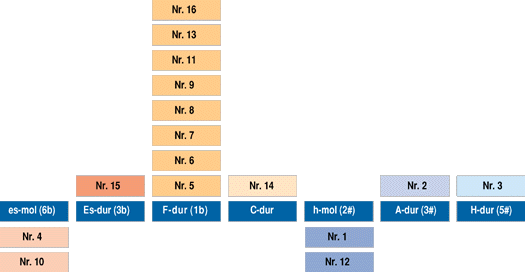Aspects & Points
Keys (especially in the symphonies)
Langgaard's music is tonal, and is to be situated - with a few exceptions - within the framework of the Late Romantic musical tradition. Some of the works contain passages without key signatures, and which have no well-definded tonality. This is especially true of Sfærernes Musik (Music of the Spheres), and Symphony No. 6 (which, however, begins and ends in the key of F major).
Keys were of a very particular significance to Langgaard. Quite a number of his compositions are in written in 'extreme' keys such as G flat major, B major and E flat minor. Indeed, two of Langgaard's symphonies (Nos. 4 and 10) are written in the key of E flat minor (6 flats), which is an unusual key for orchestral music. Langgaard associated this key with the violent moods of nature, with autumn and with decline. Another peculiarity - as may be seen from the table below - is that half of the 16 symphonies have F major as their main key. Langgaard once said that this key was the "Mother of God", and when he wrote idyllic, uncomplicated music it was often in F major. On the other hand, even some symphonies that express destructive themes (like No. 11), or are ambiguous (like No. 16), are also in F major.

![]()